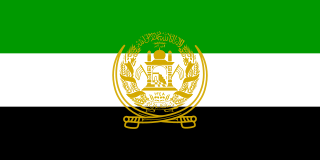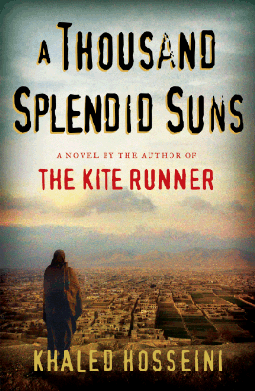
Ahmad Shah Massoud was an Afghan military leader and politician. He was a guerrilla commander during the resistance against the Soviet occupation during the Soviet–Afghan War from 1979 to 1989. In the 1990s, he led the government's military wing against rival militia, and actively fought against the Taliban, from the time the regime rose to power in 1996, and until his assassination in 2001.

Burhānuddīn Rabbānī was an Afghan politician and teacher who served as the sixth president of Afghanistan from 1992 to 1996, and again from November to December 2001.

Mohammad Najibullah Ahmadzai, commonly known as Dr. Najib, was an Afghan military officer and politician who served as the fifth president of Afghanistan from 1987 until his resignation in April 1992, shortly after the Afghan mujahideen's takeover of Kabul. He was also the General Secretary of the People's Democratic Party of Afghanistan (PDPA) from 1986 to 1992. After a failed attempt to flee to India, Najibullah remained in Kabul, and lived in the United Nations headquarters until his assassination during the Taliban's first capture of Kabul in 1996.

The Democratic Republic of Afghanistan, later known as the Republic of Afghanistan, was the Afghan state between 1978 and 1992. It was bordered by Pakistan to the east and south, by Iran to the west, by the Soviet Union to the north, and by China to the northeast. Established by the People's Democratic Party of Afghanistan (PDPA) following the Saur Revolution in April 1978, it came to rely heavily on the Soviet Union for financial and military assistance and was therefore widely considered to be a Soviet satellite state. The PDPA's rise to power is seen as the beginning of the ongoing Afghan conflict, and the majority of the country's years in existence were marked by the Soviet–Afghan War. It collapsed by the end of the First Afghan Civil War in April 1992, having lasted only four months after the dissolution of the Soviet Union.

The Soviet–Afghan War took place in the Democratic Republic of Afghanistan from December 1979 to February 1989. Marking the beginning of the protracted Afghan conflict, it saw the Soviet Union and the Afghan military fight against the rebelling Afghan mujahideen. While they were backed by various countries and organizations, the majority of the mujahideen's support came from Pakistan, the United States, the United Kingdom, China, Iran, and the Arab states of the Persian Gulf, in addition to a large influx of foreign fighters known as the Afghan Arabs. American and British involvement on the side of the mujahideen escalated the Cold War, ending a short period of relaxed Soviet Union–United States relations. Combat took place throughout the 1980s, mostly in the Afghan countryside, as most of the country's cities remained under Soviet control. The conflict resulted in the deaths of one to three million Afghans, while millions more fled from the country as refugees; most externally displaced Afghans sought refuge in Pakistan and in Iran. Between 6.5 and 11.5% of Afghanistan's erstwhile population of 13.5 million people is estimated to have been killed over the course of the Soviet–Afghan War. The decade-long confrontation between the mujahideen and the Soviet and Afghan militaries inflicted grave destruction throughout Afghanistan and has also been cited by scholars as a significant factor that contributed to the dissolution of the Soviet Union in 1991; it is for this reason that the conflict is sometimes referred to as "the Soviet Union's Vietnam" in retrospective analyses.

Gulbuddin Hekmatyar is an Afghan politician, and former mujahideen leader and drug trafficker. He is the founder and current leader of the Hezb-e-Islami Gulbuddin political party, so called after Mohammad Yunus Khalis split from Hezbi Islami in 1979 to found Hezb-i Islami Khalis. He twice served as prime minister during the 1990s.

This article on the history of Afghanistan covers the period from the fall of the Najibullah government in 1992 to the end of the international military presence in Afghanistan.

The Islamic State of Afghanistan was established by the Peshawar Accords of 26 April 1992. Many Afghan mujahideen parties participated in its creation, after the fall of the socialist government. Its power was limited due to the country's second civil war, which was won by the Taliban, who took control of Kabul in 1996. The Islamic state then transitioned to a government in exile and led the anti-Taliban Northern Alliance. It remained the internationally recognized government of Afghanistan at the United Nations until 2001, when the Transitional Islamic State of Afghanistan was created and an Afghan Interim Administration took control of Afghanistan with US and NATO assistance following the overthrow of the first Taliban government. The Transitional Islamic State was subsequently transformed into the Islamic Republic, which existed until the Taliban seized power again in 2021 following a prolonged insurgency.

Khalq was a faction of the People's Democratic Party of Afghanistan (PDPA). Its historical de facto leaders were Nur Muhammad Taraki (1967–1979), Hafizullah Amin (1979) and Sayed Mohammad Gulabzoy (1979–1990). It was also the name of the leftist newspaper produced by the same movement. The Khalq wing was formed in 1967 after the split of the party due to bitter resentment with the rival Parcham faction which had a differing revolutionary strategy.

Jamiat-e-Islami, sometimes shortened to Jamiat, is a predominantly Afghan Tajik political party and former paramilitary organisation in Afghanistan. It is the oldest and largest functioning political party in Afghanistan, and was originally formed as a student political society at Kabul University. It has a communitarian ideology based on Islamic law. During the Soviet–Afghan War and the subsequent First Afghan Civil War against the communist government, Jamiat-e Islami was one of the most powerful of the Afghan mujahideen groups. Burhanuddin Rabbani led the party from 1968 to 2011, and served as President of the Islamic State of Afghanistan from 1992 to 2001, in exile from 1996.

Mohammad Yunus Khalis was a mujahideen commander in Afghanistan during the Soviet–Afghan War. His party was called Hezb-i-Islami, the same as Gulbuddin Hekmatyar's party. The two are commonly differentiated as Hezb-e Islami Khalis and Hezb-e-Islami Gulbuddin.

Mohammad Nabi Mohammadi was an Afghan politician and mujahideen leader who was the founder and leader of the Harakat-i-Inqilab-i-Islami political party and paramilitary group. He served as President of Afghanistan under the mujahideen from January 1993 to 1996.
Mohammad Daoud was the governor of Helmand in Afghanistan until he was removed from his post for his ties to the opium trade. Daoud was appointed in December 2005, and replaced in December 2006 after the insistence of the British ISAF troops. The U.S. used the warlords to help them hunt Al Qaeda and the Taliban and it is rumored this extended to ignoring their involvement in the production and sale of opium.

The 1989–1992 Afghan Civil War, also known as the FirstAfghan Civil War, took place between the Soviet withdrawal from Afghanistan and the end of the Soviet–Afghan War on 15 February 1989 until 27 April 1992, ending the day after the proclamation of the Peshawar Accords proclaiming a new interim Afghan government which was supposed to start serving on 28 April 1992.

The 1992–1996 Afghan Civil War, also known as the Second Afghan Civil War, took place between 28 April 1992—the date a new interim Afghan government was supposed to replace the Republic of Afghanistan of President Mohammad Najibullah—and the Taliban's occupation of Kabul establishing the Islamic Emirate of Afghanistan on 27 September 1996.

A Thousand Splendid Suns is a 2007 novel by Afghan-American author Khaled Hosseini, following the huge success of his bestselling 2003 debut The Kite Runner. Mariam, an illegitimate teenager from Herat, is forced to marry a shoemaker from Kabul after a family tragedy. Laila, born a generation later, lives a relatively privileged life, but her life intersects with Mariam's when a similar tragedy forces her to accept a marriage proposal from Mariam's husband.
The following lists events that happened during 1982 in Afghanistan.

The Afghan mujahideen were Islamist militant groups that fought against the Democratic Republic of Afghanistan and the Soviet Union during the Soviet–Afghan War and the subsequent First Afghan Civil War.

The Afghan conflict is a term that refers to the series of events that have kept Afghanistan in a near-continuous state of armed conflict since the 1970s. Early instability followed the collapse of the Kingdom of Afghanistan in the largely non-violent 1973 coup d'état, which deposed Afghan monarch Mohammad Zahir Shah in absentia, ending his 40-year-long reign. With the concurrent establishment of the Republic of Afghanistan, headed by Mohammad Daoud Khan, the country's relatively peaceful and stable period in modern history came to an end. However, all-out fighting did not erupt until after 1978, when the Saur Revolution violently overthrew Khan's government and established the Democratic Republic of Afghanistan. Subsequent unrest over the radical reforms that were being pushed by the then-ruling People's Democratic Party of Afghanistan (PDPA) led to unprecedented violence, prompting a large-scale pro-PDPA military intervention by the Soviet Union in 1979. In the ensuing Soviet–Afghan War, the anti-Soviet Afghan mujahideen received extensive support from Pakistan, the United States, and Saudi Arabia in a joint covert effort that was dubbed Operation Cyclone.

The Afghan Armed Forces, officially the Armed Forces of the Islamic Emirate of Afghanistan and also referred to as the Islamic Emirate Armed Forces, is the military of Afghanistan, commanded by the Taliban government from 1997 to 2001 and since August 2021. According to Afghanistan's Ministry of Defense, its total manpower is 170,000.



















